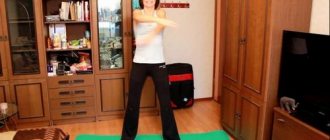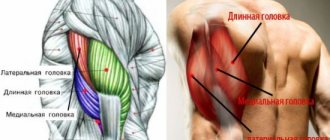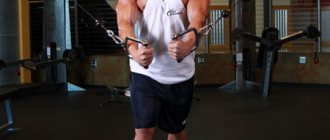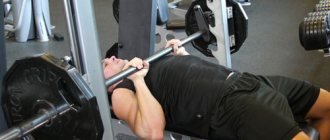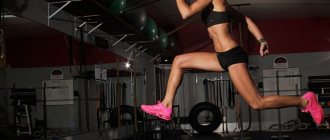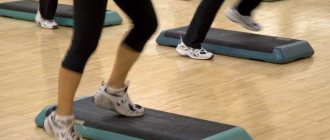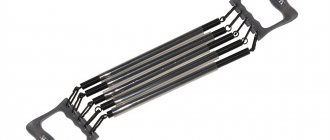Pump up your triceps at home and in the gym. What is the difference?
The main difference between home training and gym training is the lack of equipment that is necessary to work out the triceps. We have 2 ways:
- Use exercises with your own body weight. Not very effective, but suitable for beginners;
- Buy the necessary equipment to make the training complete. The best option is after 2-4 weeks of preparatory work.
To understand how to pump up triceps at home, we need to understand the exercise equipment that allows us to achieve this goal.
Exercise machines for pumping up triceps at home
Exercise machine for pumping up triceps No. 1. Complex horizontal bar-bars
The parallel bars allow you to work out the entire upper body, which allows you to follow the principle of the complex when performing squats to pump up your legs and buttocks. An inexpensive exercise machine with which you can perform basic triceps exercises.
Exercise machine for pumping up triceps No. 2. Collapsible dumbbells
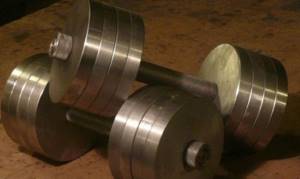
A device that allows an athlete to perform both basic and isolation movements for the triceps. Horizontal bars + collapsible dumbbells - the optimal complex for answering the question “How to pump up triceps at home?”
Exercise machine for pumping up triceps No. 3. Universal expander
An expander can replace your entire gym. Using the simulator, you can perform any exercise for each muscle group. It costs tens of times less than dumbbells and is easily stored out of sight without taking up space. It's easy to train outdoors with an expander. It fits into a small bag or wide pocket, almost weightless. The expander is a recovery workout that can speed up the recovery of triceps and other muscle groups. Everyone should have this trainer. The expander is not without its drawbacks: you won’t be able to build muscles like Schwarzenegger’s with it. Training with an expander helps pump up your triceps, but you shouldn’t have any illusions.
Exercise machine for pumping up triceps No. 4. Rubber loops

When answering the question “How to pump up triceps at home?” rubber loops act as an alternative to an expander. With the help of loops you can pump any part of the body, any muscle. The arsenal of exercises is slightly narrower than when working with an expander, but many times wider than when working with dumbbells or developing triceps on parallel bars. Rubber loops with different resistances promote compliance with the principle of progression of loads - the basis of pumping muscles.
How to speed up the growth process?
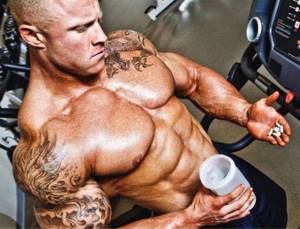
The rapid and harmonious development of the triceps depends, first of all, on regular training. However, we must not forget about enhanced nutrition of growing muscles with protein and amino acids. To speed up the process of muscle growth and your progress in strength indicators, you need to give your body high-quality “fuel” and the necessary “building material” for new muscle fibers.
Modern sports nutrition not only saturates muscles with protein and amino acids (proteins and BCAAs). There are special sports nutrition for weight loss, getting rid of fat and maintaining muscle mass. There is a sports nutrition that will allow you to start training any day in an alert and fresh state (pre-workout). And so on. All of these are real means of accelerating development and growth, which make sense to take advantage of. And without sports nutrition, by training hard, you can achieve impressive results. But with sports nutrition, you can get the most out of every workout, accelerating the approach of your goal.
For those who are just deciding whether they need sports nutrition, we recorded a video below:
We recommend: buy sports nutrition on this site. Sports nutrition that works!
Exercises to pump up your triceps at home
Exercise for pumping up triceps No. 1. Pushups
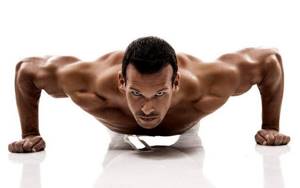
The simplest exercise you can do right now. There is one caveat: the narrower the position of the hands, the more the triceps are involved in the work. The wider, the more the pectoral muscles and deltoids work. Our option is to alternate between a medium hand position and a narrow position.
Exercise for pumping up triceps No. 2. Dips

Push-ups on uneven bars at home can be:
- An addition to standard push-ups;
- The basis of triceps training. In this version we use weights. Not immediately, but after passing a certain level of experience.
Dips with an emphasis on the triceps have a nuance: when performing the movement, you should not lean forward; we press our elbows to the body. Otherwise, the pectoral muscles will work, not the triceps. The effectiveness of dips on parallel bars is significantly increased by a weight belt and plates as a weighting agent. You can use regular weights, but the effect is worse. Anyone who wants to build triceps quickly should have a weight belt.
Exercise for pumping up triceps No. 3. Bench press

We squeeze dumbbells or a barbell. The best option is to have an adjustable bench with the ability to use an angle of 45 degrees. The 45-degree bench press is an effective exercise, but rarely used at home due to the lack of equipment.
Exercise for triceps at home No. 4. Extension of arms with a projectile from behind the head
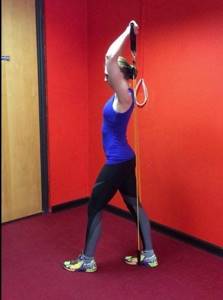
Dumbbells, an expander or a rubber loop act as a projectile. The best isolation exercise for the triceps, without which muscle pumping is greatly slowed down
Exercise for triceps at home No. 5. Retraction of arms with the projectile back

Another isolation exercise that can be performed with similar equipment. Used as a complement to or replacement for overhead arm extensions.
Exercise for triceps at home No. 6. Press with apparatus up
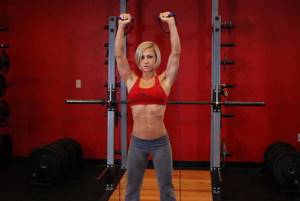
Analogous to the standing barbell press. Performed with dumbbells, expander or loops. It pumps up not only the triceps, but also the middle and anterior deltoids, which improves the appearance of the shoulder girdle.
Principles of pumping up triceps at home
All of the above exercises for pumping up the triceps at home do not work without understanding two principles:
- The principle of load progression;
- The principle of supercompensation.
How to pump up triceps at home? The principle of load progression
The principle warns: the athlete must regularly (every 1-3 sessions) increase the load if he really wants to pump up his triceps at home. Using push-ups as an example, the principle of load progression looks like this: Workout No. 1
| Exercise | Approaches | Repetitions | Rest minutes between sets |
| Narrow push-ups | 3 | 5 | 1,5 |
Workout #2
| Exercise | Approaches | Repetitions | Rest minutes between sets |
| Narrow push-ups | 3 | 6 | 1,5 |
Workout #3
| Exercise | Approaches | Repetitions | Rest minutes between sets |
| Narrow push-ups | 3 | 7 | 1,5 |
Workout #4
| Exercise | Approaches | Repetitions | Rest minutes between sets |
| Narrow push-ups | 3 | 8 | 1,5 |
Workout #5
| Exercise | Approaches | Repetitions | Rest minutes between sets |
| Narrow push-ups | 4 | 8 | 1,5 |
Workout #6
| Exercise | Approaches | Repetitions | Rest minutes between sets |
| Narrow push-ups | 4 | 9 | 1,5 |
Workout #7
| Exercise | Approaches | Repetitions | Rest minutes between sets |
| Narrow push-ups | 4 | 10 | 1,5 |
Workout #8
| Exercise | Approaches | Repetitions | Rest minutes between sets |
| Narrow push-ups | 5 | 10 | 1,5 |
Workout #9
| Exercise | Approaches | Repetitions | Rest minutes between sets |
| Narrow push-ups | 5 | 11 | 1,5 |
Workout #10
| Exercise | Approaches | Repetitions | Rest minutes between sets |
| Narrow push-ups | 5 | 12 | 1,5 |
Workout #11
| Exercise | Approaches | Repetitions | Rest minutes between sets |
| Narrow push-ups | 5 | 12 | 1 |
Workout #12
| Exercise | Approaches | Repetitions | Rest minutes between sets |
| Narrow push-ups | 6 | 12 | 1 |
The point is to regularly increase the number of approaches, repetitions, increase the number of repetitions or reduce rest. These programs may be a first for beginners who don't know how to do push-ups.
How often to train triceps at home? Supercompensation principle

The training process is divided into 4 parts:
- Training . Muscles are injured, muscle cells receive microtrauma. To understand how to pump up your triceps, you need to realize: muscles don’t grow during training!
- Recovery . Muscles are restored after received microtraumas. You cannot train during the recovery process. Your muscles are weaker than before the workout. The principle of load progression cannot be observed;
- Supercompensation . The body creates a reserve of muscles to reduce stress when going through a similar workout. In this phase, the muscles are stronger than in the previous workout. Only here can the principle of progression of loads be observed without overexertion.
- Loss of super compensation . A consequence of lack of training for a long time.
The speed at which all phases occur is different for everyone. For beginners, it is better to rely on muscle pain, the absence of which means the end of the recovery phase. A beginner can conduct from 2 to 4 workouts per week. Work on triceps – 2-3 times a week Read more here.
Recommendations for training
Triceps is a triceps muscle that occupies the back of the shoulder and consists of a long, medial and lateral head. The main function of the triceps is to extend the elbow. The triceps occupy almost 70% of the entire volume of the arm, so pumping it up allows you to significantly increase mass.

© bilderzwerg — stock.adobe.com
A well-designed triceps is not only beautiful and attractive. This is also the key to the success of other workouts. For example, triceps are necessary for pumping up the muscles of the chest and deltoids, since with any bench press you cannot do without the triceps muscle.
To make triceps training effective, follow several recommendations that have been developed by reputable athletes over many years of practice:
- Choose the number of exercises and approaches wisely. If you do triceps after a chest workout, two exercises of 3-4 sets will be enough. If you train your arms separately, you need 3-4 exercises of 3 approaches.
- Select the correct working weight and feel the working muscle. Weight is determined in practice. Do not cheat unless you are an experienced athlete. If you do not feel the target muscle group during the exercise, reduce the weight or replace it with a similar one.
- Increase the weight gradually. A sudden increase in load increases the risk of muscle or joint injury. When increasing the working weight, be sure to monitor your technique - it should not deteriorate.
- Vary your training. There are a lot of exercises for triceps. Alternate them periodically, using both base and insulating ones.
- Do triceps stretches between sets. This stretches the fascia and improves neuromuscular communication.
- Train your triceps in combination with chest, shoulder or biceps exercises. With legs or back - rare combinations that are used only by experienced athletes for certain purposes.
- Do not overdo it. The load on the triceps muscle should be intense, but not frequent. Once a week will be enough. The exception is specialization in hands (not for beginners).
- Don't neglect warming up. Be sure to warm up your joints and muscles for 5-10 minutes before training.
When doing triceps exercises, do them in such a way as to pump this particular muscle. Often athletes violate technique and, as a result, do not achieve the desired result or even get injured. If you don't know the basics of doing basic triceps exercises, work with an instructor.
